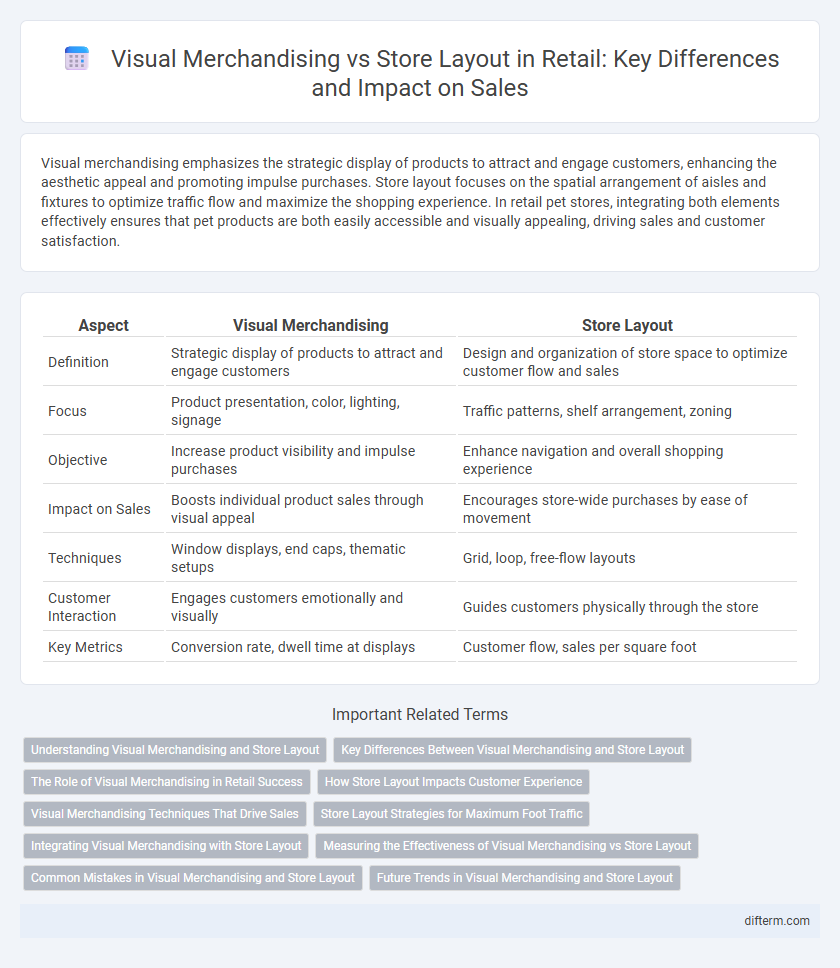Visual merchandising emphasizes the strategic display of products to attract and engage customers, enhancing the aesthetic appeal and promoting impulse purchases. Store layout focuses on the spatial arrangement of aisles and fixtures to optimize traffic flow and maximize the shopping experience. In retail pet stores, integrating both elements effectively ensures that pet products are both easily accessible and visually appealing, driving sales and customer satisfaction.
Table of Comparison
| Aspect | Visual Merchandising | Store Layout |
|---|---|---|
| Definition | Strategic display of products to attract and engage customers | Design and organization of store space to optimize customer flow and sales |
| Focus | Product presentation, color, lighting, signage | Traffic patterns, shelf arrangement, zoning |
| Objective | Increase product visibility and impulse purchases | Enhance navigation and overall shopping experience |
| Impact on Sales | Boosts individual product sales through visual appeal | Encourages store-wide purchases by ease of movement |
| Techniques | Window displays, end caps, thematic setups | Grid, loop, free-flow layouts |
| Customer Interaction | Engages customers emotionally and visually | Guides customers physically through the store |
| Key Metrics | Conversion rate, dwell time at displays | Customer flow, sales per square foot |
Understanding Visual Merchandising and Store Layout
Visual merchandising focuses on creating compelling displays and product arrangements to attract customers' attention and enhance the shopping experience, using elements like lighting, color, and signage. Store layout, on the other hand, involves designing the overall floor plan to optimize traffic flow, product placement, and accessibility, influencing how shoppers navigate the space. Understanding the interplay between visual merchandising and store layout is essential for increasing sales, improving customer engagement, and maximizing retail space efficiency.
Key Differences Between Visual Merchandising and Store Layout
Visual merchandising emphasizes the strategic presentation of products to create appealing displays that drive customer engagement and enhance brand perception. Store layout concentrates on the overall physical arrangement of aisles, fixtures, and signage to optimize traffic flow and maximize space utilization. Key differences include visual merchandising's focus on aesthetics and storytelling versus store layout's priority on spatial efficiency and navigation.
The Role of Visual Merchandising in Retail Success
Visual merchandising plays a critical role in retail success by strategically presenting products to enhance customer engagement and drive sales, complementing the functional arrangement of store layout. Effective visual merchandising uses signage, lighting, colors, and display techniques to create an inviting atmosphere that influences purchase decisions and brand perception. While store layout optimizes traffic flow and accessibility, visual merchandising directly impacts emotional connection and impulse buying, making it essential for maximizing retail performance.
How Store Layout Impacts Customer Experience
An effective store layout directly influences customer navigation, encouraging longer visits and increased purchases through intuitive pathways and strategically placed product displays. By optimizing aisle width, fixture arrangement, and focal points, retailers create an engaging environment that enhances product visibility and comfort. This thoughtful design leads to improved customer satisfaction, higher conversion rates, and ultimately stronger sales performance.
Visual Merchandising Techniques That Drive Sales
Visual merchandising techniques such as themed displays, strategic lighting, and interactive product placements significantly enhance customer engagement and increase sales conversion rates. Implementing color psychology and focal points directs shopper attention to high-margin items, optimizing purchase behavior within the store layout. Effective visual merchandising integrates sensory appeal and clear signage, creating an immersive retail experience that boosts average transaction value.
Store Layout Strategies for Maximum Foot Traffic
Effective store layout strategies maximize foot traffic by strategically organizing product placements to guide customer flow and encourage longer visits. Techniques such as grid layouts, loop designs, and focal points direct shoppers through high-margin areas while enhancing the overall shopping experience. Optimizing aisle width, signage, and checkout positioning further increases engagement and sales conversion rates in retail environments.
Integrating Visual Merchandising with Store Layout
Integrating visual merchandising with store layout enhances customer journey by strategically placing eye-catching displays in high-traffic zones, increasing product visibility and encouraging impulse buys. Tailoring store layout to complement visual merchandising techniques helps create thematic consistency, driving brand identity and improving overall shopping experience. Optimized integration boosts sales conversion rates by guiding customer flow and emphasizing key product categories through impactful presentation.
Measuring the Effectiveness of Visual Merchandising vs Store Layout
Measuring the effectiveness of visual merchandising involves analyzing sales lift, customer dwell time, and engagement with product displays, whereas store layout evaluation focuses on traffic flow patterns, conversion rates, and average transaction value. Tools such as heat maps, sales data analytics, and customer feedback surveys provide quantitative insights for both strategies. Combining these metrics helps retailers optimize the in-store experience to maximize revenue and enhance customer satisfaction.
Common Mistakes in Visual Merchandising and Store Layout
Common mistakes in visual merchandising include overcrowding displays, inconsistent branding, and poor lighting, which can confuse customers and reduce product visibility. In store layout, errors such as confusing navigation paths, ineffective use of space, and neglecting customer flow patterns hinder shopper experience and decrease sales potential. Retailers must optimize both elements by balancing aesthetic appeal with functional design to enhance engagement and drive conversions.
Future Trends in Visual Merchandising and Store Layout
Future trends in visual merchandising highlight the integration of augmented reality (AR) and interactive digital displays to create immersive shopping experiences that boost customer engagement. Store layouts are evolving toward flexible, modular designs that accommodate omnichannel strategies and personalized shopping journeys, driven by advanced data analytics. The convergence of smart technology and experiential retail is set to redefine spatial organization, enhancing both aesthetic appeal and operational efficiency.
visual merchandising vs store layout Infographic

 difterm.com
difterm.com